#Louis XV fashion
Text

Susan, Mrs. Henry Hoare by William Hoare of Bath (auctioned by Sotheby's). From their Web site; navigation marks and a few spots in the background removed with Photoshop 1595X2077.
#1730s fashion#Georgian fashion#Rococo fashion#Louis XV fashion#Mrs. Henry Hoare#William Hoare of Bath#feathered hat#paned sleeves
71 notes
·
View notes
Photo
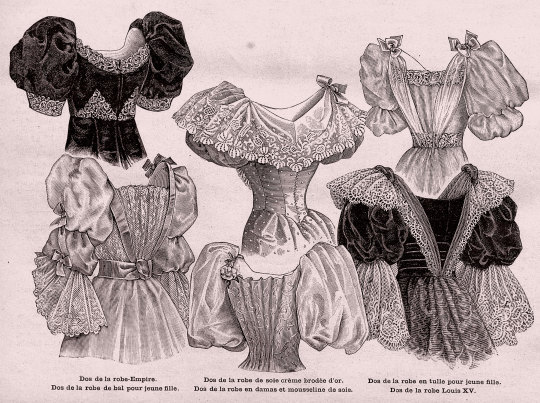

La Mode illustrée, no. 51, 18 décembre 1892, Paris. Toilettes de bal. Modèles de chez Mmes Coussinet-Piret, rue Richer, 43. Ville de Paris / Bibliothèque Forney
Dos de la robe-Empire. Dos de la robe de bal pour jeune fille. Dos de la robe de soie crème brodée d'or. Dos de la robe en damas et mousseline de soie. Dos de la robe en tulle pour jeune fille. Dos de la robe Louis XV.
Toilette en soie glaçée. Toilette-Empire. Robe de bal pour jeune fille. Robe en damas et mousseline de soie. Robe en tulle pour jeune fille. Robe Louis XV. Robe en soie crème brodée d'or. Robe en mousseline brodée pour jeune fille. Robe de bal Empire. Robe Louis XIV.
#La Mode illustrée#19th century#1890s#1892#periodical#fashion#fashion plate#Forney#dress#gown#ball#evening#Louis XV#Louis XIV#gigot#devant et dos#empire#Modèles de chez#Madames Coussinet-Piret
431 notes
·
View notes
Text


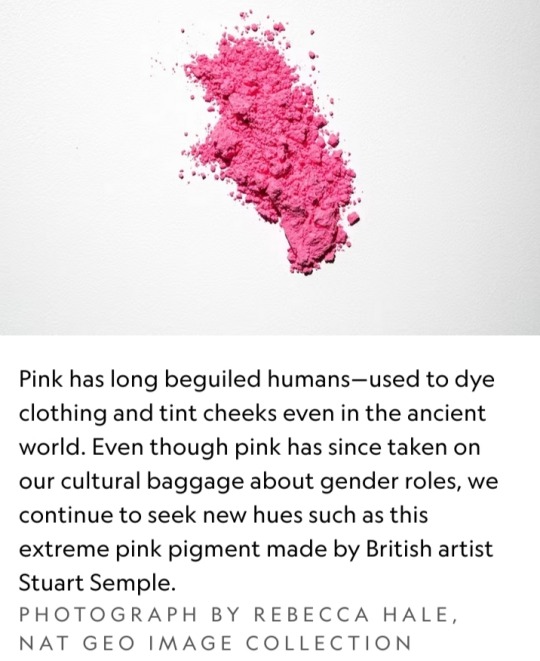
Could pink be Earth’s oldest color? That’s the implication of a 2018 study that found bright-pink pigments in 1.1 billion-year-old rocks — thanks to the fossils of the billions of tiny cyanobacteria that once dominated oceans.
The natural world has long been painted with every permutation of pink — whether embedded deep in ancient rock, sported by shrimp-hungry flamingoes, or simply lining the shores of Bermuda’s pink-sand beaches.
And yet the color carries a lot of cultural baggage.
As pink made the jump from nature’s palette to human adornment, it gathered connotations of colonialism, beauty, power, and gender.
How did pink become such a cultural flashpoint? As the world takes a revitalized interest in the hot-pink planet inhabited by Barbie, here’s a short history of the compelling color.
Admiration for pink in the ancient world
Early humans quickly transitioned from admiring pink in the natural world to attempting to wear it.
For example, in the Andes Mountains about 9,000 years ago, fierce hunters in what is now Peru wore tailored leather clothing with a pink hue thanks to red ochre, an iron oxide pigment that is one of the oldest natural pigments used by humans.
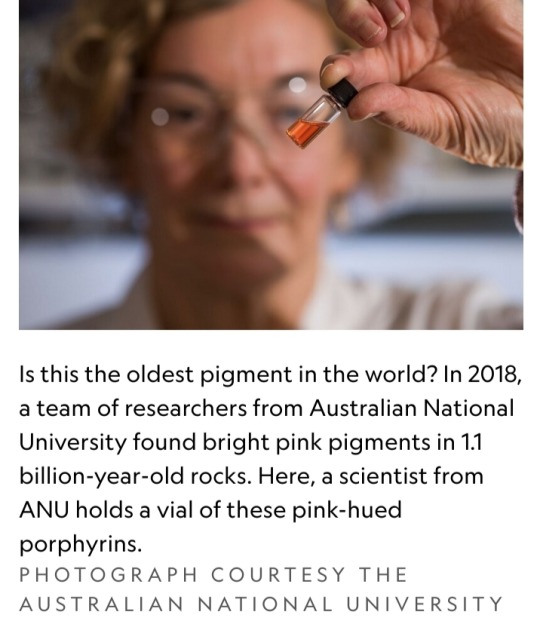
Humans weren’t content just to smear this pigment on cave walls or use it while tanning their leather garments.
As far back as ancient Egypt, humans used ochre to tint their lips and cheeks.
When applied to human skin, the red pigment created a blush-like pink that onlookers associated with love, sexuality, and beauty.
Lookalike concoctions prevailed around the world, employing everything from crushed strawberries to red amaranth.
The color of cosmetics—and colonialism
Though the word’s etymology is unknown, the word “pink” was used to describe the color in the 18th century.
By then, pink had become inextricably tied with colonialism — as demand for the pigment for cosmetics drove Europeans to harvest natural resources in other parts of the world.
For example, in a bid to make pinkish pigments from the bark and red sap of brazilwood trees, European traders forced enslaved workers to cut down so many of Brazil’s eponymous trees that the country was left deforested and the tree nearly driven extinct.
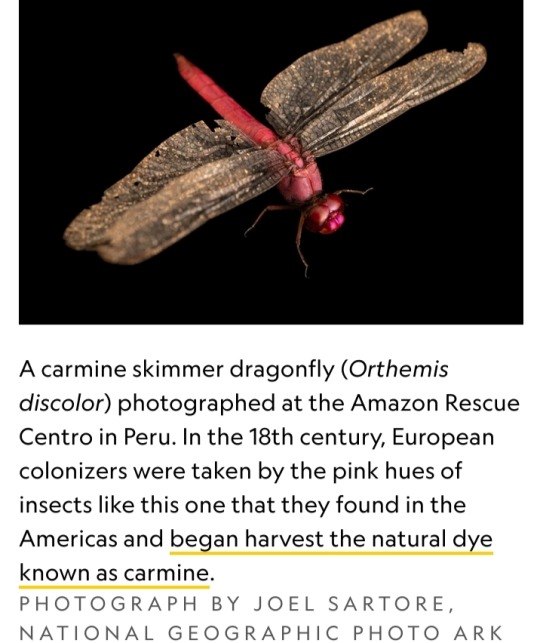
During this Era of Exploration, consumers also got their pink cheeks and lips from other pigments like carmine, derived from cochineal insects harvested in Central and South America under similar conditions.
Meanwhile, the color also had a more literal association with colonialism:
During this time, the British Empire grew so massive that the color pink — which mapmakers used to mark its territories worldwide — dominated the world map.
Pink becomes a bona fide fashion craze
As red tints became more accessible and cheaper, 18th-century European aristocrats indulged a passion for pink.
Art historian Michel Pastoureau writes that “the most privileged classes of European society wanted pastels, halftones, and the newest innovations in color shades in order to distinguish themselves from the middle classes, who now had access to bright, strong, and reliable colors.”
Madame de Pompadour, the mistress of Louis XV of France during the 1740s and 1750s, used the color as a signature.
The artists who painted her and created fine objects for her many homes used pink in all their designs, even her carriages, and she helped further popularize the hue throughout Europe.
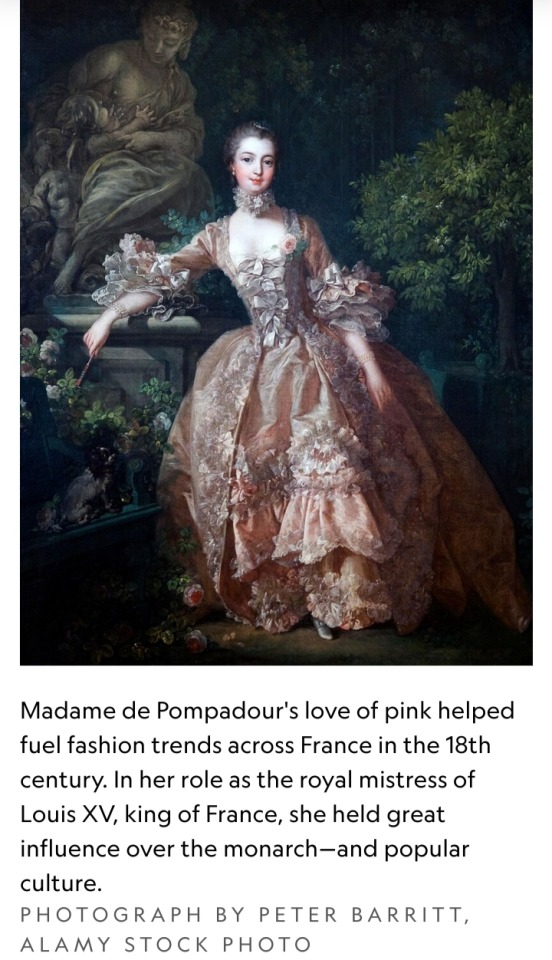
The emergence of synthetic dyes in the mid-19th century — which gave rise to the purple-pink color known as mauve — made pink more accessible than ever before.
By the 1930s, bright pink had become a bona fide fashion craze.
Avant-garde fashion designer Elsa Schiaparelli made “shocking pink” her signature color, helping spread the vogue for women’s wear.
It worked: By 1935, even local newspapers like the News and Observer in Raleigh, North Carolina, were declaring that “PINK IS FAVORITE.”
And in 1939, a royal commentator wrote in London’s Daily Telegraph that pink was so popular, it was nearly ubiquitous for both bridesmaids and debutantes.
“So general is the pink craze,” the paper wrote, “that some women are rebelling against it.”
Pink is for…boys?
Around the same time, pink gained relevance in another realm: baby fashion.
Gender and baby fashion had intersected for years; around World War I, etiquette guides and fashion advice columns began advising that mothers dress their children in clothing with gender-specific hues.
But which colors? A 1927 retailer survey on infant clothing colors published in TIME shows a split nation, with retailers like Filene’s and Marshall Field’s recommending pink for boys, but Macy’s, Bullock’s, and others claiming pink was best for girls.
By the 1960s, however, mothers began buying pink clothing for their female babies, dressing their male children in pastel blues.
“None of this transition happened by childcare expert fiat or industry proclamation,” writes historian Jo B. Paoletti.
Instead, pink gained steam as a signifier of a baby’s female sex as part of a post-World War II push to reinforce traditional gender roles in American homes — and the realization by retailers that they could make more money that way.

“The more baby clothing could be designed for an individual child — and sex was the easiest and most obvious way to distinguish babies — the harder it would be for parents to hand down clothing from one child to the next, and the more clothing they would have to buy as their family grew,” Paoletti writes.
Soon, retailers featured entire “pink aisles” packed with pink-colored clothing and toys for tiny consumers.
The dark side of pink
Pink was also rejected by some as a symbol of weakness or even sinister intent.
In Nazi Germany, for example, the color was used to brand gay men in concentration and death camps.
As the Cold War emerged, suspected Communist sympathizers were given the derogatory name of “pinkos” — a term that referred to a person with “red” tendencies toward radical politics.
Meanwhile, members of the women’s liberation movement attempted to distance themselves from a color that had become inextricably linked with femininity and sexuality — think: Marilyn Monroe slinking down a staircase in a shocking pink gown, surrounded by tuxedoed men.
Anti-feminists, meanwhile, embraced pink.
Author Helen B. Andelin, for example, made public appearances in all-pink ensembles in the 1960s and 1970s during lectures encouraging women to abandon feminism and embrace lives as housewives.
Reclaiming pink
Pink remains associated with femininity to this day — but in recent decades, groups once disdainfully branded with the color have made moves to reclaim it.
In the LGBTQ community, for example, people who were once forced to wear pink as outcasts have adopted the hue as a symbol of their movement for social justice.
In 1987, the AIDS Coalition to Unleash Power (ACT UP) adopted a bubble-gum pink triangle in its “Silence = Death” campaign to increase awareness of HIV-AIDS and destigmatize the disease.
It was just one example of pink being used to represent gay pride.
Some feminists have also reclaimed the color, fighting gender stereotypes with a tongue-in-cheek adoption of all shades of rose, fuchsia, and bubble-gum pink.
At the 2017 Women’s March, for example, a sea of protesters wearing pink, cat-eared “pussy hats” protested the inauguration of U.S. President Donald Trump, whose lewd remarks about female genitalia during a leaked interview drew worldwide condemnation.
Today, pink is what you make of it — and it has grown in popularity once more.
In 2016, Pantone announced that a shade of dusty pink — dubbed Millennial Pink for the generation that had embraced it—was its Color of the Year.

This year, Greta Gerwig’s upcoming Barbie movie helped fuel the rise of the pink-drenched “Barbiecore” aesthetic, inspiring admirers to saturate their homes and wardrobes with every shade of pink.
According to Axios, searches for the term “Barbiecore aesthetic room” rose over 1,000 percent between May 2022 and May 2023, reflecting consumers’ craving for as-pink-as-possible interiors.
There’s no telling which permutation of pink will captivate us next — but given the colorful history of the hues that fall somewhere between white and red, pink’s next heyday is probably right around the corner.

Barbie would approve of the pink petals on this beach morning glory.
Pink flowers like this one get their rosy tinge from a group of biological pigments called anthocyanins, which attract pollinators — and human admirers — to colors ranging from the palest carnation to the most ostentatious tropical fuchsia.
#pink#red ochre#carmine#Era of Exploration#Madame de Pompadour#Louis XV of France#mauve#Elsa Schiaparelli#gender#baby fashion#colors#Helen B. Andelin#AIDS Coalition to Unleash Power (ACT UP)#Pantone#Millennial Pink#Barbie#Nat Geo#fashion#political movement#Marilyn Monroe#Zsa Zsa Gabor#pigment
10 notes
·
View notes
Text
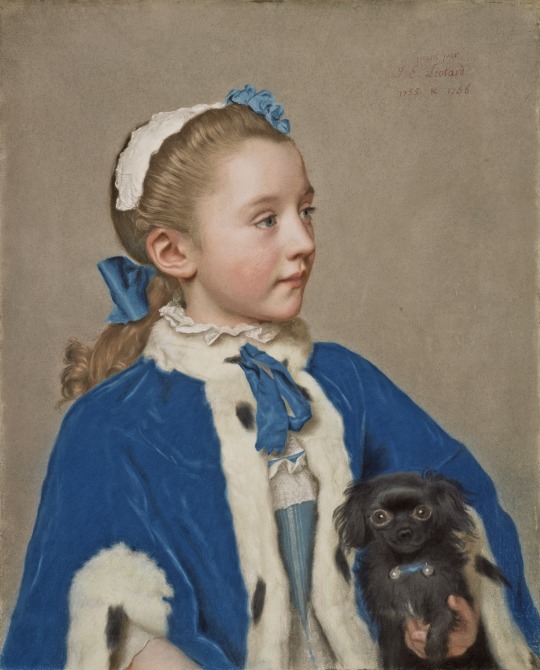
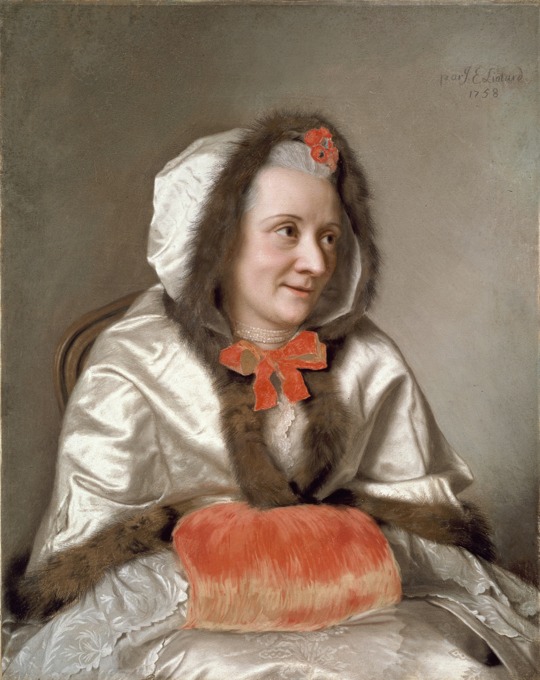
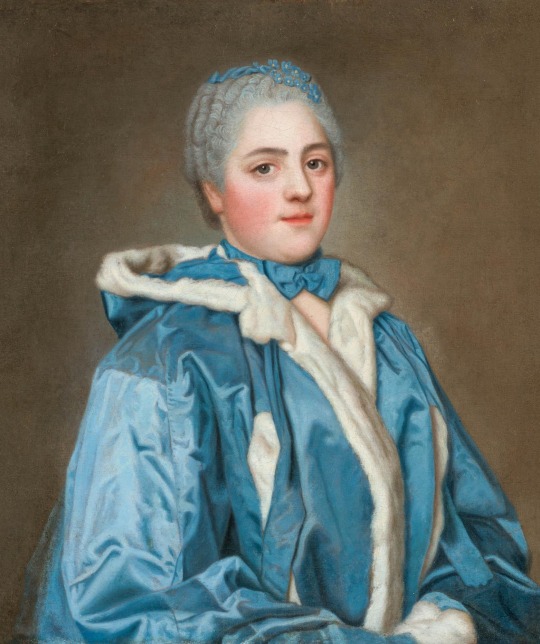
Jean-Étienne Liotard
Maria Frederike van Reede-Athlone, 1755-56
Portrait of Madame François Tronchin, 1758
Portrait de Marie-Thérèse-Victoire de France, after 1749
#my posts#Jean-Étienne Liotard#Liotard#fashion#art#Louis xv#Louis xv style#18th century art#18th century#18th century style#18th century fashion#my post#fashion history#French art#paintings#1750s#1750s fashion
3 notes
·
View notes
Text
Here is the post about Charles-André van Loo. A shorter version.

His painting - Perseus and Andromeda
Carle or Charles-André van Loo ( 15 February 1705 – 15 July 1765) was the most famous member of the successful dynasty of painters of Dutch origin. His oeuvre includes every category: religion, history painting, mythology, portraiture, allegory, and genre scenes.
He was born in Nice, then part of the Duchy of Savoy. Van Loo followed his brother Jean-Baptiste (the guy from my previous post) to Turin, and then to Rome in 1712, where he studied under Benedetto Luti and the sculptor Pierre Le Gros. After leaving Italy in 1723, he worked in Paris, studied at the Académie Royale, where he gained first prize for drawing in 1723, and received the first prize for historical painting in 1727—as did his future rival François Boucher. In 1724 he won the Prix de Rome (a French scholarship for arts students, that was established in 1663 during the reign of Louis XIV of France. Winners were allowed them to stay in Rome for three to five years at the expense of the state). After again visiting Turin in 1727, he was employed by king Victor Amadeus II of Sardinia. In 1734 he settled in Paris, and in 1735 became a member of the Académie royale de peinture et de sculpture and rose rapidly in the hierarchy of the academy. Madame de Pompadour and the French court were taking the artist under their patronage. He was decorated with the Order of Saint Michael and named First Painter to king Louis XV of France in 1762.He was a most successful court painter but his portraits as well as history paintings also enjoyed an enormous success throughout all Europe. He died in Paris on 15 July 1765.
Some of his portraits:
Marie Leczinska, Queen of France

Louis XV, king of France

Madame de Pompadour

#new post#historical fashion#artwork#art#painter#oil painting#oil on canvas#portrait#queen of france#king of france#madame de pompadour#marie leczinska#louis xv of france#perseus#perseus and andromeda#historical#history#art history#dutch painter#Nice#new to tumblr#dress#period piece#period drama#Rome#royals#royal style#royalty#palace of versailles#versailles
10 notes
·
View notes
Text
AT THE COURT OF KING LOUIS XV OF FRANCE 🇨🇵 - LAST DECADE OF HIS REIGN (1764-1774)

I started this #drawingcenturies project on my Instagram (Melisvstheworld_)
I'm going to illustrate women from the past, based on decades and centuries. If you want to follow me on IG to see more, feel free to do It.
Thank You to all of you ❤️
#french#frenchhistory#louis xv of france#history#artwork#digital drawing#digital art#digital painting#instagram#fashion#history of fashion#drawings#follow on instagram#pastel pink
2 notes
·
View notes
Text









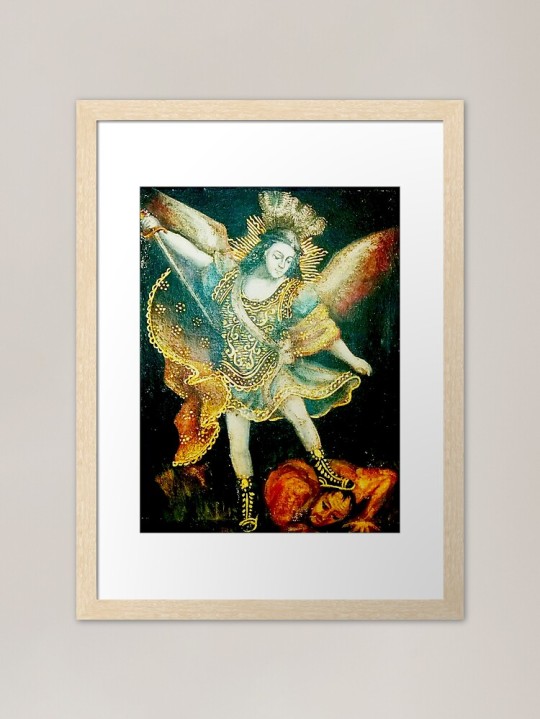
#fashion#decor ideas#pretty#bedroom#bedding#floral#flowers#homedesign#throw pillow#design#louis xv of france#louis xvi#vintage interior#homedecor#interiordesigner#homestyle#homeinterior#interiordesign#pink#pink aesthetic#pastel pink#paisley
0 notes
Photo
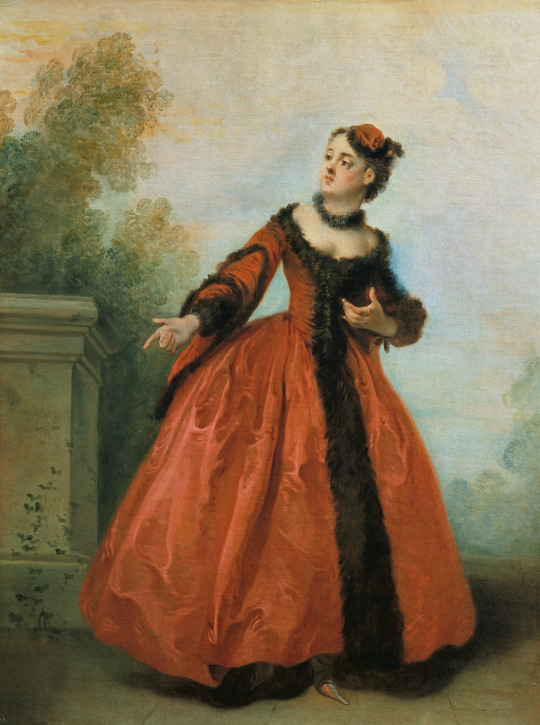




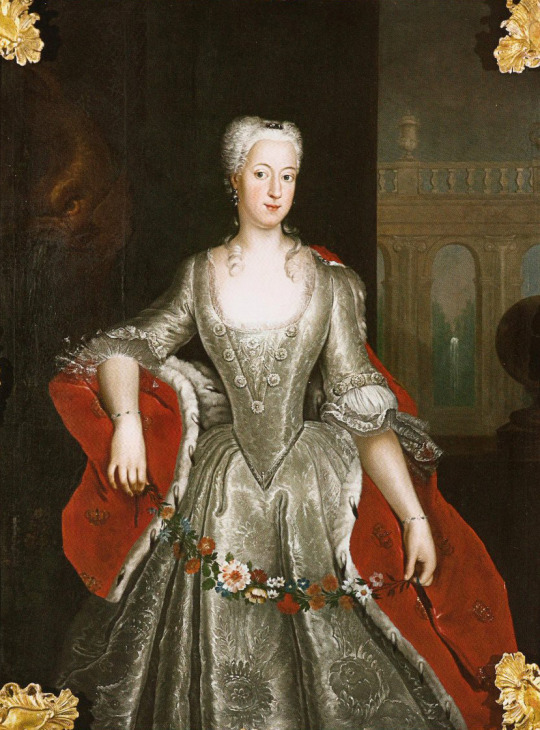
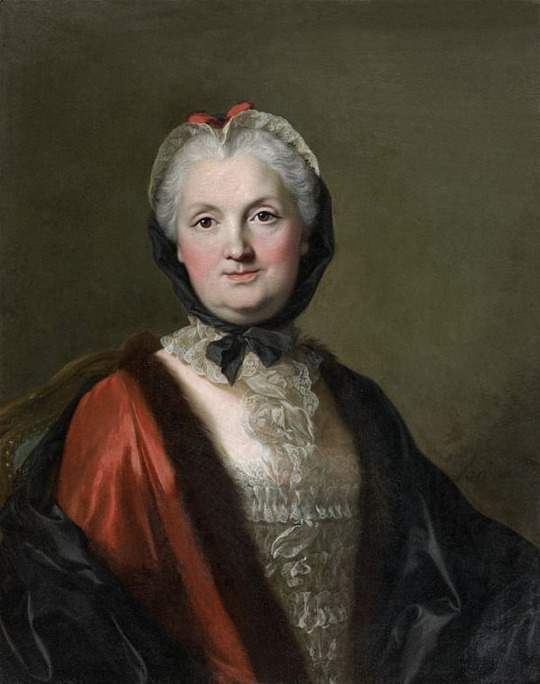
Early 1730s dresses and portraits (from top to bottom) -
ca. 1732 The Beautiful Greek (La Belle Grecque) by Nicolas Lancret (Wallace Collection - London, UK). From their Web site 1429X1960, The complex sleeves open at the top like they would in Russian court dresses a century later.
ca. 1732 Watson-Wentworth and Finch Families by Charles Philips (Yale Center for British Art, Yale University - New Haven, Connecticut, USA) persons. From Wikimedia 4902X3094. The décolletage-filling fichu would become prominent in the Louis XVI era, but just about every grown up woman wears one along with a fastened bodice, round skirt, and apron. The heads of every female are covered by a cap, veil, or hat.
1733 Marie-Geneviève le Tonnellier de Breteuil by French school (attributed to Alexis Simon Belle) (auctioned by Sala de Ventas).From invaluable.com/auction-lot/18th-century-french-school-alexis-simon-belle-a-646-c-2074af1b03 1940X3362.Round skirts flourish on both shores of the channel.
ca. 1730-1735 Lady by Joseph Highmore (National Gallery of Art - Washington, DC, USA). From their Web site 1148X1495. The cuffed outer sleeves are stuffed by under-sleeves and the dress lining has a very subdued pink contrasting with the gold color of the other layer.
1734 Princess Sophie Dorothea with Friedrich Wilhelm by Antoine Pesne (location ?). From Wikimedia1633X2611. Textiles with large patterns characterize the early 1700s. Her dress has a square neckline.suggesting French influence.
ca. 1734 Wilhelmine of Prussia, Margravine of Brandenburg-Bayreuth by Antoine Pesne (location ?). From Wikimedia 829X11221. The silver brocade over-bodice has a deep V neckline filled in with scoop neckline.
1734 Madame Marie du Tour Vuillard (1695- 1759), née Robin by Louis Michel Van Loo (Tajan - 12-12-12 auction Lot 37), From their Web site; fixed spots & flaws w Pshop 2487X3151.
#1730s fashion#Georgian fashion#Louis XV fashion#Rococo fashion.#The Beautiful Greek#Nicolas Lancret#fur-trimmed dress#Charles Philips#Marie-Geneviève le Tonnellier de Breteuil#Alexis Simon Belle#curly hair#tabbed bodice#Joseph Highmore#Princess Sophie Dorothea#Antoine Pesne#Wilhelmine of Prussia#Madame Marie du Tour Vuillard#Louis Michel Van Loo#wire cap#lace choker#fur trim
74 notes
·
View notes
Photo
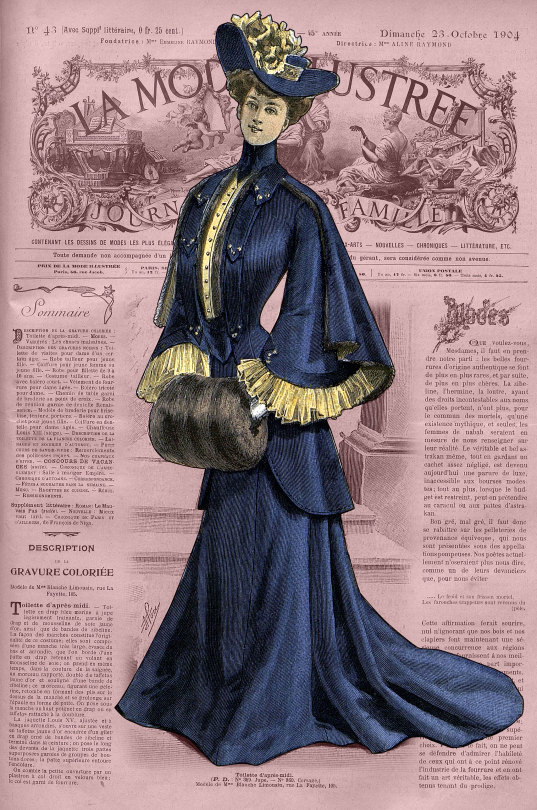
La Mode illustrée, no. 43, 23 octobre 1904, Paris. Toilette d'après-midi. Modèle de Mme Blanche Limousin, rue La Fayette, 105. Ville de Paris / Bibliothèque Forney
Description de la gravure coloriée:
Toilette en drap bleu marine à jupe légèrement traînante, garnie de drap et de mousseline de soie jaune d'or, ainsi que de bandes de zibeline. La façon des manches constitue l'originalité de ce costume; elles sont composées d'une manche très large, évasée du bas et arrondie, que l'on borde d'une patte en drap retenant un volant en mousseline de soie; on prend en même temps, dans la couture de la saignée, un morceau rapporté, doublé de taffetas jaune d'or et souligné d'une bande de zibeline; ce morceau, figurant une pèlerine, retombe en formant des plis sur le dessus de la manche et se prolonge sur l'épaule en forme de patte. On pose sous la manche un haut poignet en drap ou en taffetas rattaché à la doublure.
La jaquette Louis XV, ajustée et à basques arrondies, s'ouvre sur une veste en taffetas jaune d'or encadrée d'un gilet en drap orné de bandes de zibeline et terminé dans fa ceinture; on pose le long des devants de la jaquette trois pattes superposées garnies de groupes de boutons dorés; la patte supérieure entoure l'encolure.
On comble la petite ouverture par un plastron à col droit en velours bleu; le col est garni de fourrure.
—
Navy blue broadcloth ensemble with a slightly trailing skirt, trimmed with golden yellow broadcloth and silk muslin, as well as strips of sable. The way of the sleeves constitutes the originality of this costume; they are composed of a very wide sleeve, flared at the bottom and rounded, which is edged with a cloth placket holding a silk muslin flounce; one takes at the same time, in the seam of the bleeding, an added piece, lined with golden yellow taffeta and underlined with a band of sable; this piece, depicting a cape, falls in pleats on the top of the sleeve and extends over the shoulder in the shape of a paw. A high cuff in cloth or taffeta attached to the lining is placed under the sleeve.
The Louis XV jacket, fitted and with rounded basques, opens onto a golden yellow taffeta jacket framed by a cloth waistcoat adorned with strips of sable and finished in the belt; one poses along the fronts of the jacket three overlapping tabs furnished with groups of golden buttons; the upper tab surrounds the neckline.
The small opening is filled with a plastron with a straight collar in blue velvet; the collar is trimmed with fur.
#La Mode illustrée#20th century#1900s#1904#periodical#fashion#fashion plate#cover#color#description#Forney#dress#blue#yellow#broadcloth#train#Louis XV#cape#Modèles de chez#Madame Blanche Limousin
165 notes
·
View notes
Text


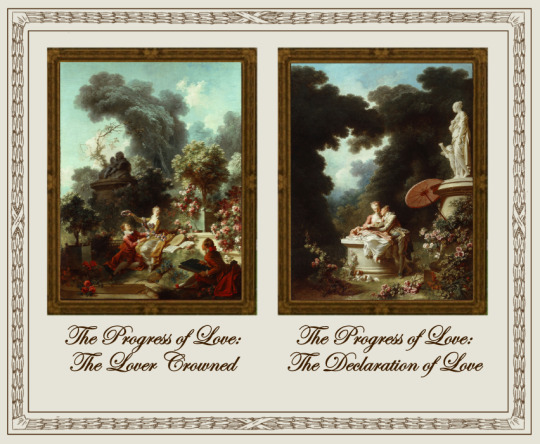
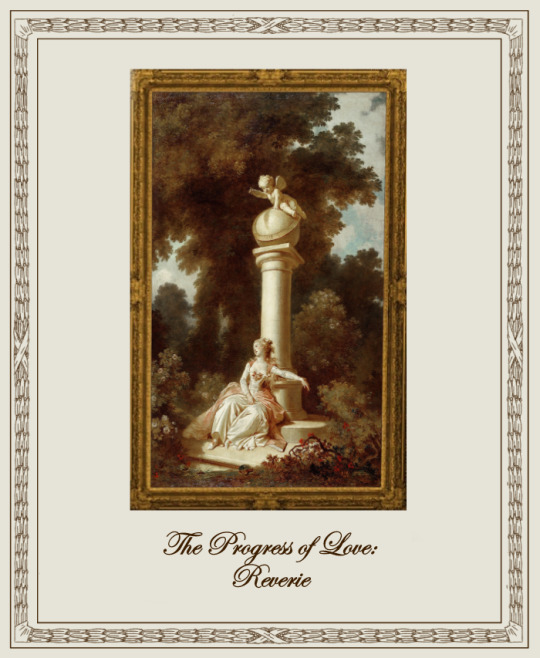
The Progress of Love Set
A retexture by La Comtesse Zouboff — Original Mesh by @thejim07
First of all, I'm terribly sorry for the lack of content lately, I've had some major issues and now my computer is not available to me, since it's being repaired, but in the meantime, enjoy this little rococo set!
The history of these paintings-one of the most powerful evocations of love in the history of art-is linked with the career of Jeanne Bécu, Countess du Barry the last mistress of Louis XV. For a pleasure pavilion in Louveciennes she commissioned from the architect Claude-Nicolas Ledoux in 1771, the countess ordered from Fragonard four canvases depicting "the four ages of love." The series advances in the following order: from a flirtatious proposal (the pursuit), to a furtive meeting (the lover scales the wall of a garden), to consummation or marriage (the girl crowns her lover with roses), to the calm enjoyment of a happy union (the reading of love letters). Yet, for all their beauty and passion, Madame du Barry soon returned the canvases to the artist and ordered replacements from another. Were the resemblances between the red-coated lover and Louis XV potentially embarrassing? Did the exuberant canvases seem a little old-fashioned amid the cool neoclassicism of Ledoux's avant- garde pavilion? For whatever reason, Fragonard was left holding on to his creations for another twenty years. Then, adding seven more canvases, (although the original series contains five canvases) he installed the series in a cousin's villa in southern France. They passed through the collection of J. P. Morgan, where they were displayed in his London house. They were acquired by Frick in 1915 and installed in a room specially designed for them where they remain to this day.
-------------------------------------------------------
This set contains 5 paintings with the original frame swatches, fully recolourable. They are:
The Progress of Love: The Pursuit.
The Progress of Love: The Meeting.
The Progress of Love: The Lover Crowned.
The Progress of Love: The Declaration of Love.
The Progress of Love: Reverie.
Found under decor > paintings for: 3.900§ (1-4) and 3.560§ (5)
Retextured from:
"Portrait of Maria Theresa of Austria and her Son, le Grand Dauphin" (1-4) found here
"Length Portrait of Mrs.D" (5) found here
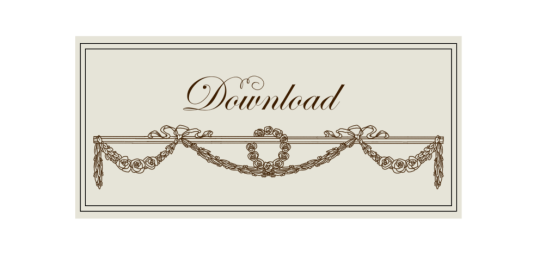
Drive
(Sims3pack | Package)
(Useful tags below)
@joojconverts @ts3history @ts3historicalccfinds @deniisu-sims @katsujiiccfinds @gifappels-stuff
-------------------------------------------------------
#the sims 3#ts3#s3cc#sims 3#sims 3 cc#sims 3 download#sims 3 decor#portrait#wall decor#fragonard#rococo
79 notes
·
View notes
Text
Jeanne du Barry: A review
I watched it, so you don’t have to!
There was a preview screening of Jeanne du Barry that coincided with a presentation on 18th century fashion and hygiene, so I figured that would make for a pleasant Sunday. The lecture by Marta Veil was splendid.
The movie was… not.
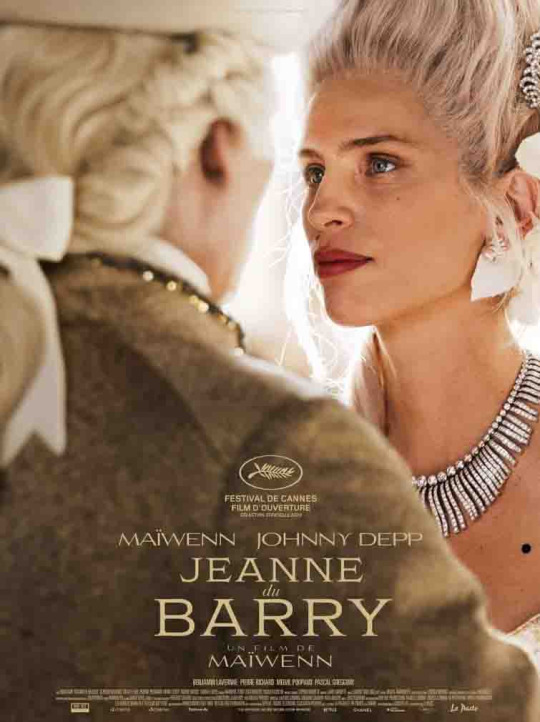
I wasn't expecting greatness, really, but I also wasn't expecting it to fail in quite so many ways. Shall we count them?
First, it falls flat as a piece of cinema. The ponderous shots just scream second-year-film-student-auteur. The narration, usually a gimmick, is critical because the directorial vision seems to have been ��tell, don’t show”. It’s all glamour with no heart, a faux-profound fashion parade that fails to let its consequential story beats resonate on any emotional or narrative level. Despite being told about the constant danger than Jeanne is in, we never feel it. Despite witnessing her tragedies, we don't empathise.
The lead actor-director gives du Barry none of the wit, charm or depth you would expect of the subject of a biography, and most characters are either outrageous caricatures (the evil, Alice in Wonderlandian step-daughters, complete with heart-shaped perms) or have the nuance and magnetism of an untoasted slice of white bread (the Dauphin, a key side character, shows not a single discernible character trait besides “aloof”).
Second, it fails as a biography. Maïwenn, the woman responsible for this mess, has apparently been trying to bring this story to life for over a decade - and then manages to give us nothing more than the blow-for-blow you can get from the du Barry Wikipedia article - dryness and all.
(It’s also exceedingly clear that Maïwenn got more than a little 'inspired’ by Sofia Coppola’s Marie Antoinette, and ironically - given their historical rivalry and the way Coppola's Antoinette was lifted wholesale from her film - the Dauphine outshines du Barry completely here.)
Despite being a biography, the movie devotes very little attention to Jeanne’s coming of age - and almost no time (literally, a 30-second narration) to the 12+ years of her life after Louis’ death, which include such dramatic things as her being betrayed by her servants, tried and executed in the wake of the French Revolution. Very little of her internal world is explored - so we don’t really understand what drives her, and even when she expresses her goals it comes across as insincere.
The bulk of the movie focuses on Jeanne’s time as Louis XV’s lover. That’s understandable, I guess - people want the sexy, sparkly intrigues, not the convent drudgery - but the movie doesn’t do any work to embrace the politics and scandal surrounding her on more than the meanest surface level. I mean - "this is Versailles!" (A line that’s cribbed verbatim from Coppola.) Where are the machinations, the manoeuvres? The only meaningful drama we get is domestic. Louis’ daughters don’t like his mistress. They’re mean to her. And… that’s it.
Most egregiously, the movie makes the unrecoverable error of losing grasp of its own point of view. We ostensibly follow Jeanne for most of the movie, in what is made out to be a limited first-person perspective. But when she’s banished from Versailles, we get to witness the unfolding events without her. After all, the death of Louis XV is surely more interesting than some woman bundled off to a convent (wait— who is this movie about…?) and so we stay with him - and miss the opportunity to follow Jeanne and empathise with her isolation, fear and grief.
If the goal of the movie was to humanise and rehabilitate du Barry, then maybe she shouldn’t have been made so vapid, boring and lacking in agency that her own biography lost interest in her.
Third, it fails as a historical piece. Not entirely - some of the men’s fashions are sumptuous and on point, Marie Antoinette is chef’s-kiss, and Versailles looks splendid on screen - but that makes the rest worse, somehow.
Again, we get Coppola plagiarism, in the form of Louis’ morning dressing routine (with the same comical play on the endless steps and bored attendants), as well as in many of du Barry’s fish-out-of-water moments.
But the movie forgets its own rules and context. For example, we’re told that “no one except the Dauphin is allowed to turn their back on the king” - a rule that’s respected until about midway in the movie, at which point, its plot purpose exhaused, it's forgotten entirely. Jeanne is also surprisingly enlightened about racial equality, showcased in painful scenes with Zamor, her black… servant? slave? Although it’s not really clarified on screen, the former is heavily implied, which would be gross revisionism.
Even Louis is treated with a strange sort of familiarity, left to mill around with his guests in the hall of mirrors or stroll the gardens with his hair undone.
As for the clothing… I can’t bear to deep-dive into the entirety of the mess, but here are a few examples of just how lazy the styling is.
Now, when he’s done up in his finery, Louis XV actually looks grand - and even (what a rarity) has very decent period men’s make-up. But then it’s clowns all the way down. Take this shot.

Just behind him is his daughter, sporting a top-of-the-pops 1980s crimped blowout, and beside her is the Dauphin of France - though you could be mistaken for thinking he’s some fella getting to pose for a romance novel cover in the world's most ill-fitting suit. (I don’t recall this man tying his hair up one single time for the duration of the movie.)
Some of the critique is a little nitpicky, yes - for example, du Barry wears this outfit to be formally presented to the king:
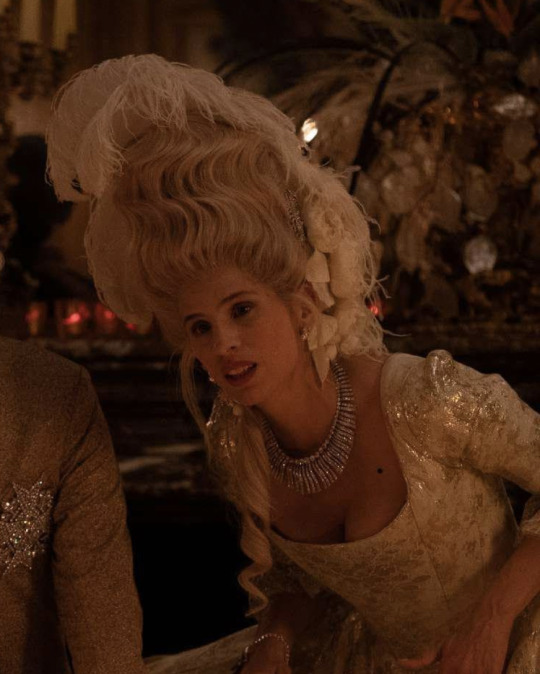
The big hair and ostrich feathers are a decade too early (stop trying to be Marie Antoinette: The Unauthorised Prequel already), the makeup is mid 2000s, and the necklace... the less said about it, the better. But at least an attempt was made!
But this?
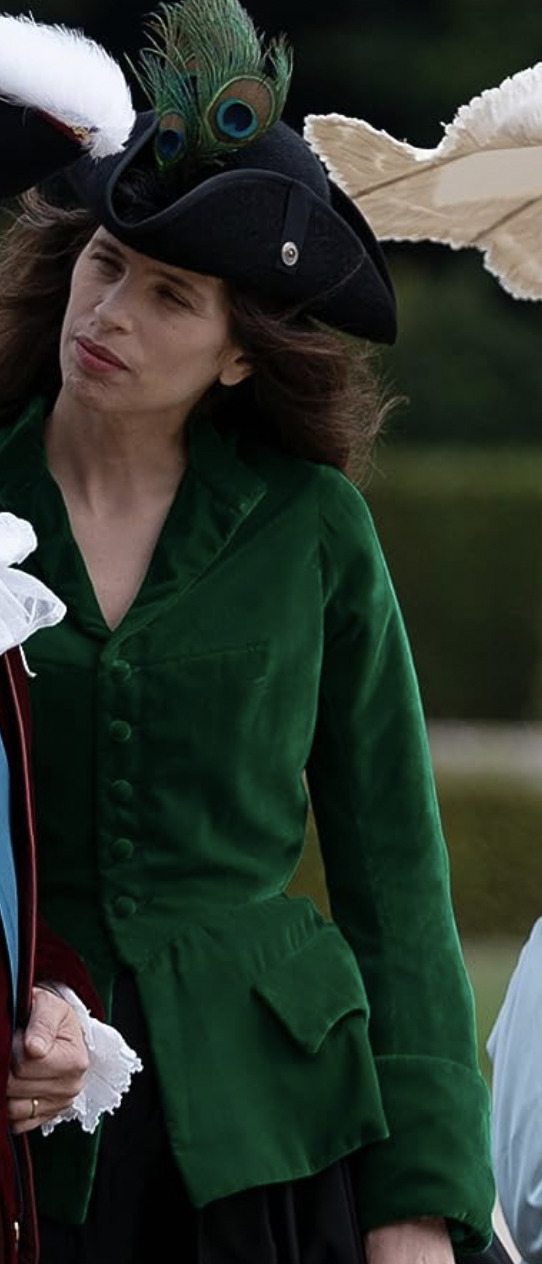
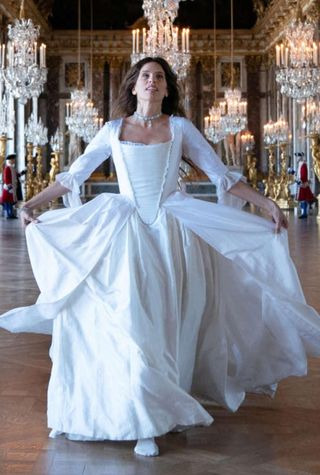

And this???
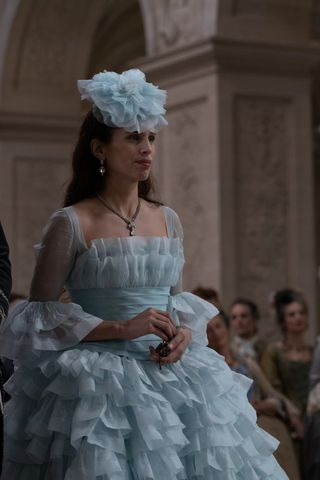
0.5 out of 5 stars. It would have been zero on account of all the plagiarism, but a half-star is given for the cameo of Elizabeth Vigée Le Brun.
#jeanne du barry#jeanne du barry movie#18th century history#18th century fashion#but only just barely
76 notes
·
View notes
Text
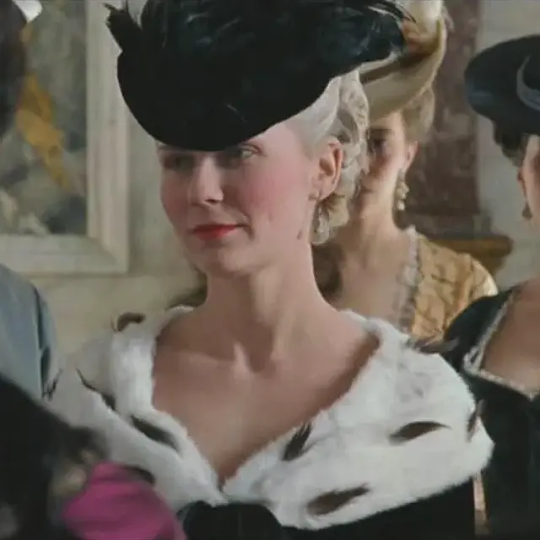


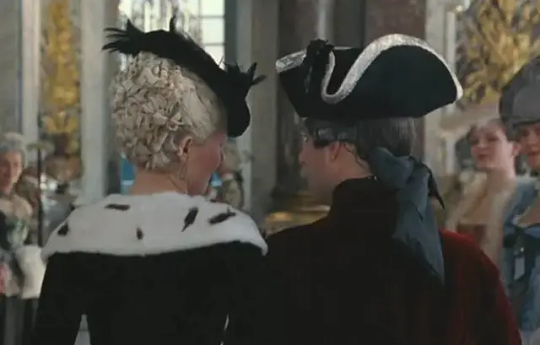
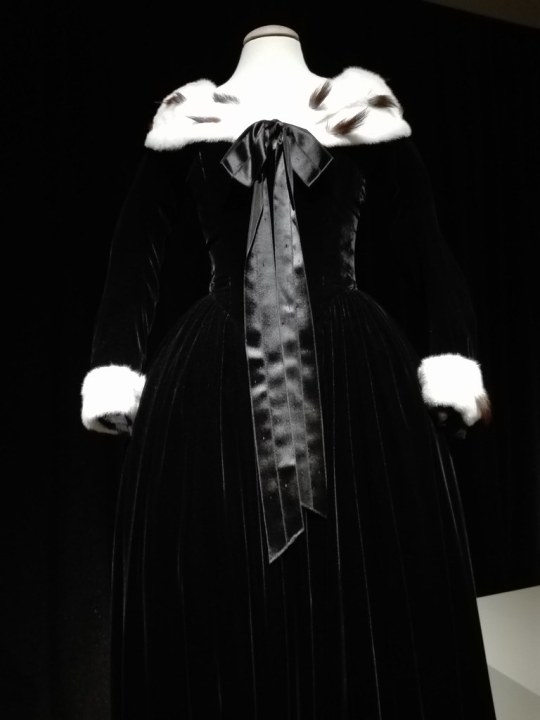
One Dress a Day Challenge
Black and White October
Marie Antoinette / Kirsten Dunst as Marie Antoinette
This elegant ermine-trimmed black gown appears in a brief scene where Marie exchanges an uncomfortable few obligatory words with the late king's mistress. Fortunately, it has been exhibited, so we can better appreciate its uncluttered lines and the extravagant black ribbon bow in front.
Looks like the dress itself might be made of velvet. It is very likely based on a fashion plate of the 1770s (see below), which fits, since Louis XV died in 1774.

#marie antoinette 2006#black and white october#kirsten dunst#one dress a day challenge#one dress a week challenge#movie costumes#period film#2006 movies#2006 films#18th century costumes#18th century fashion#18th century style#marie antoinette#1770s#1770s fashion#1770s style#milena canonero
34 notes
·
View notes
Text




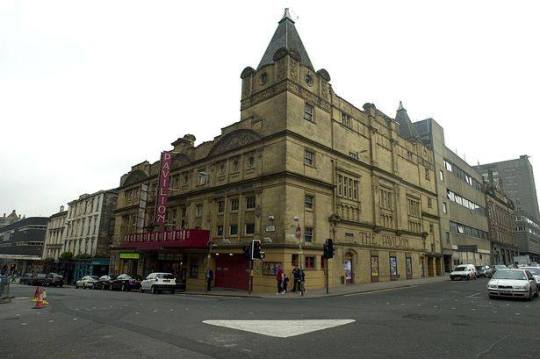
On 29th February 1904 the Pavilion Theatre, Glasgow, opened.
Designed by Bertie Crewe for Thomas Barrasford, the Pavilion Theatre opened at the corner of Renfield Street and Renfrew Street, Glasgow on the 29 February, 1904. It was regarded as luxurious for its time with its decor being described by the owners as “pure Louis XV”. An electrically operated sliding roof ensured good ventilation.
Performances in the early days were mainly variety, melodrama and pantomime. Many of the leading music hall artistes of the period appeared at the Pavilion, including Marie Lloyd, Little Tich, Harry Lauder, Florrie Forde, Will Fyffe, Sarah Bernhardt and a then unknown Charlie Chaplin.
Since the 1930s, the Pavilion began to host pantomimes with top name stars of the Scottish variety scene, such as Harry Gordon and Dave Willis. In more recent times it has produced plays, such as ‘The Sash’ and ‘The Steamie’.
The Pavilion Theatre is now the only privately run theatre in Scotland and one of a few unsubsidised independent theatres left in Britain.
“Defying all the odds, Glasgow’s Pavilion regularly purveys variety to this day. All the more remarkable as it is completely unsubsidised and receives no funding from the Scottish Arts Council and kindred bodies whose thoughts and cash are directed at higher cultural activities. It remains the last stronghold of a long music hall tradition in Europe’s City of Culture owing everything to a dedicated staff and patrons and nothing to the public purse.
With its imposing terra cotta facade, the Pavilion Theatre of Varieties was designed by Bertie Crewe in the grand manner for Thomas Barrasford. The domed ceiling was surmounted by an electrically controlled sliding roof for ventilation. Fine Rococo plasterwork on the circle, balcony and box fronts; decoration executed in pure Louis XV; handsome mahogany woodwork and the marble mosaic floor all lent the 1800 seat theatre an aura of splendour.
No less amusing than the dentist advertising in the Pavilion programme “painless extractions with nitrous oxide for 4/- (20p) or cocaine for 1/- (5p)”, were the press observations on the “fashionable company” which attended the Pavilion’s first house on 29th February,1904. We learn that “among the elite there was quite a preponderance of ladies and gentlemen of quality in evening dress”. Alas, class consciousness and respectability were all in Edwardian Britain!
The ‘forties and ‘fifties saw pantomime runs of sixteen weeks, the happy and hilarious summer seasons were emulated during the 1960s and early 1970s by Lex McLean. Another regular crowd puller to Renfield Street was Jack Milroy.
Lulu from Dennistoun (real name Marie Lawrie) broke box office records in 1975, Billy Connolly, Hector Nicol Andy Cameron portrayed their own distinctive brands of humour while Scottish songstresses Lena Zavaroni, , Sheena Easton, Lena Martell and Barbara Dickson also scored heavily with Pavilion audiences.
It was anything but plain sailing for the Pavilion and there was gloomy speculation of closure after incurring heavy financial losses in 1981. Spared the fate which befell the Queens, Metropole, Empire, Alhambra and Empress Theatres, the 80 years old Pavilion was rescued by James Glasgow and transformed into a modest profit maker. Smash-hit shows with Sydney Devine; spells from hypnotist Robert Halpern; pantomime with Denny Willis, and one night gigs from the foremost modern television entertainers have kept the cash tills registering.
The Pavilion also played a major role in the annual Mayfest – Glasgow’s International Festival of popular theatre, music, the arts and community programmes.
Little altered and virtually unspoilt since its inception, the seating capacity of 1449 is made up of 677 stalls, 341 circle, 413 balcony and 18 box seats. While the stiff shirts in chauffeur-driven cabs have given way to coach parties from the rural areas of Strathclyde and beyond, a policy of providing the best in live entertainment has been pursued consistently. The portents look good for the vibrant Pavilion Theatre of Varieties.”
The Pavillion is, in my view a survivor, even over the past few years tragedy has struck the area with a series of fires.
13 notes
·
View notes
Text

Sébastien-Charles Giraud (French, 1819-1892) • Painting Princess Mathilde’s Conservatory in the Mansion on Rue de Courcelles, Paris • 1864
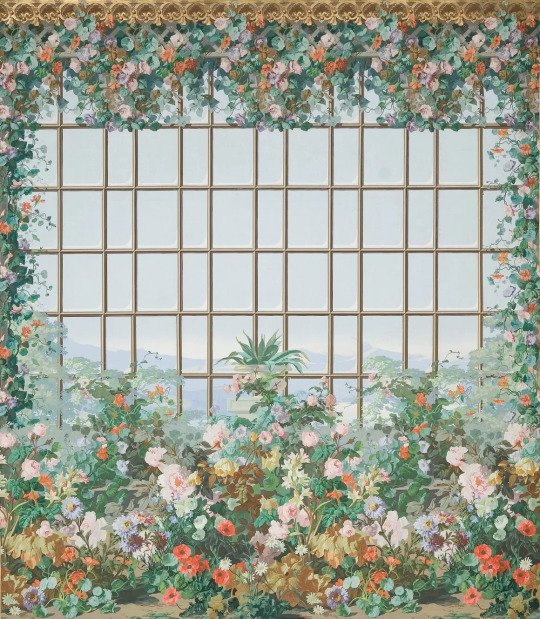
JULES DESFOSSÉ FACTORY (1851-1947) • WALLPAPER – Winter Garden • France • 1853
Princess Mathilde, cousin of Napoleon III, was a key figure in the society life of the Second Empire. After an unhappy marriage to the wealthy Prince Demidoff, she settled in Paris where she lived lavishly, entertaining all the intellectuals, politicians and artists of the day in the drawing rooms of her luxurious mansion on Rue de Courcelles. Many of her guests - such as Flaubert, the Goncourt brothers, Sainte-Beuve and Ernest Renan – paid tribute to her generosity.The views of the princess’s home painted by Charles Giraud are meticulous renderings of her living environoment. She liked to welcome her friends in the conservatory, depicted in this painting with a soft light filtering through the exotic vegetation on the walls and a variety of furniture pieces and objects taking up the center of the room: a table, a Louis XV armchair, a Moorish pedestal table, some oriental vases and precious objects of all origins – an eclectic selection, therefore, that is highly representative of the spirit of the times.
Conservatories came into fashion with the London Exhibition of 1851 when the glass roof of the Crystal Palace caused a sensation. The wallpaper displayed here, designed by Edouard Muller for the Desfossé factory and entitled Winter Garden is another reflection of this. Jules Desfossé made a significant contribution to the revival of panoramic wallpapers but abandoned the series of scenes telling a story in favor of large landscapes and decorations which he considered worthy of great paintings. – Musée des Arts Décoratifs, Paris
#art#fine art#sébastien-charles giraud#art history#historical painting#princess mathilde#jules desfossé#french designer#paintings of interiors#paintings of conservatories#the painted room art blog#painting#wallpaper design#art lesson#paris#french mansion
14 notes
·
View notes
Text
Rose-colored
In France under Louis XV it was Madame de Pompadour who made pink the fashion for furnishings and decor. She loved to combine it with sky blue, two tones that won her favor and that rapidly became the rage throughout Europe. But with regard to clothing, it was as much the men as the women who wore pink; that color was not in the least especially feminine yet. On the other hand, it was no longer considered a particular shade of yellow, but was now firmly seen as a mixture of red and white. Our modern pink was thus born sometime toward the middle of the eighteenth century. In French it was given a new name, no longer derived from the facial complexion but from the color of flower petals: the rose created the French color rose. Over the course of decades, botanists and gardeners had succeeded in creating increasingly numerous varieties of roses, and roses that were truly rose, unknown in Antiquity and the Middle Ages, had become common. These changes, however, took place very, very slowly. In the French language, the adjective and the noun rose were not definitively established as descriptors of the color we know by that name until the nineteenth century. The same is true in Spanish (rosa), Portuguese (cor-de-rosa), and German (rosa). As for the English word pink, for a long time it designated only the dyestuff extracted from brazilwood, before -belatedly- it came to describe the color obtained from that same wood.
Michel Pastoureau - Red, the History of a Color
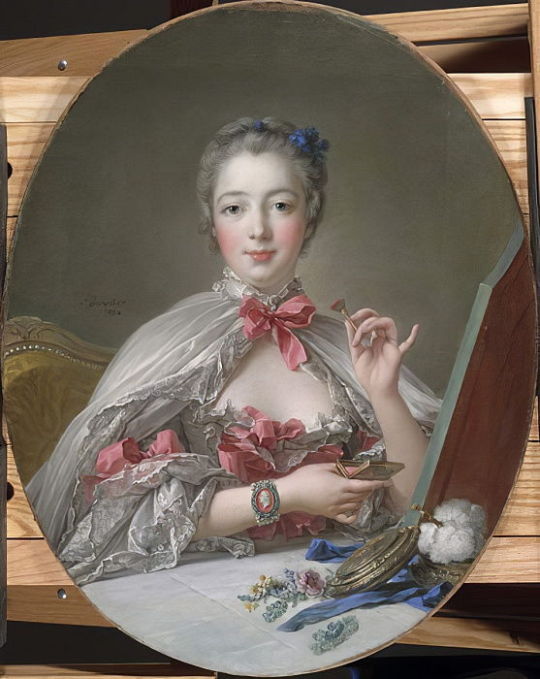
28 notes
·
View notes
Text
Even in this tiny chapter Hugo cannot limit himself to just one topic. We learn something about M. Gillenormand’s hair: “always dressed in “dog’s ears” – I am trying to visualize this and the image is just too funny. These “dog’s ears” do not quite align with the following claim that “he was venerable in spite of all this.” We also learn his previous address. And this: “He had something of the eighteenth century about him” – well, we have already noticed it and more than once!
There is something very decadent in his habit of not excepting anyone until evening. He himself declares it to be “fashionable” but this is obviously a fashion from the times of Louis XV.
I'm not sure if Hugo intended it as a wicked irony, but the phrase "he barricaded himself against everyone" does have that tone to it.
22 notes
·
View notes